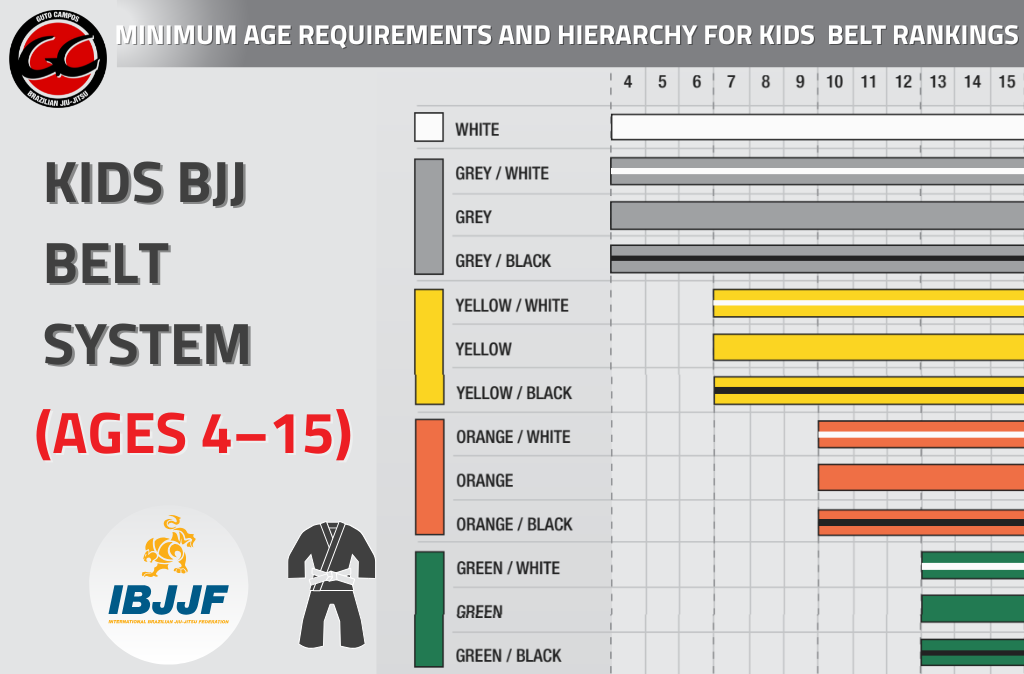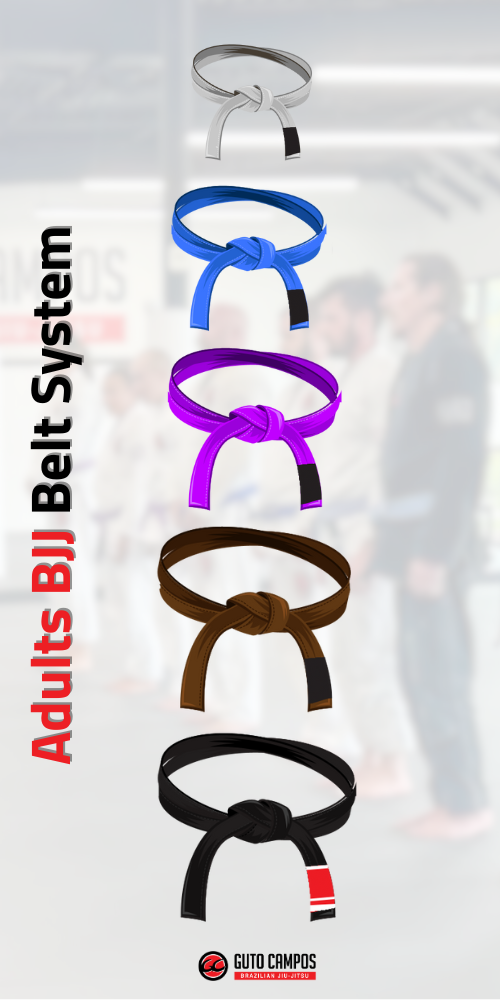BJJ Belt Rankings: What’s the Path to Achieve a Black Belt?
In Brazilian Jiu-Jitsu, belts aren’t just colors; they represent how far you’ve come, how much you’ve learned, and how you carry yourself on the mat.
At Guto Campos BJJ Academy in Orlando, we work with students of all backgrounds, from complete beginners to experienced competitors, and one question always comes up: “How do BJJ belt rankings work?”
This blog breaks it down clearly. From white belt to red, we’ll walk through how promotions happen, what the IBJJF requires, how instructors make decisions, and why progress in BJJ is about more than just time.
Let’s dive into the journey.
KEY TAKEAWAYS
(BJJ Belt Rankings Explained)
- BJJ Belts (Adult): White → Blue → Purple → Brown → Black.
- Kids Belts: Gray → Yellow → Orange → Green (then adult belts at age 16).
- Stripes: Each belt has 4 stripes to track progress before promotion.
- Time to Black Belt: 8–12 years on average.
- Black Belt Degrees: 6 degrees (up to Coral and Red Belts at higher levels).
- Promotion Rules: IBJJF/CBJJ require minimum time, skill, and instructor rank.
- Most People Quit: At blue belt, but that’s where the real journey begins.
- Key Insight from Our Academy: Belt rankings reflect who you’ve become, not just what you can do.
- Beyond Belts: BJJ is a lifelong practice of discipline, learning, and humility.
Kids BJJ Belt System (Ages 4–15)
BJJ belt rankings for kids are designed to encourage growth, motivation, and focus at every stage. Instead of the adult five-belt path, children progress through a series of belts that reward consistent effort and technical improvement.

The belt progression goes:
White → ⬜️ Gray → 🟨 Yellow → 🟧 Orange → 🟩 Green
Each belt comes in three versions: white-striped, solid, and black-striped. Between each belt, kids may earn up to four stripes, typically based on attendance, effort, and progress.
Promotions aren’t just about performance; they also recognize attitude, discipline, and consistency. Most academies use a stripe system to help keep students engaged between belt promotions.
Children progress through these belts in order, regardless of their starting age. The IBJJF system allows students ages 4 to 15 to follow this path at their own pace.
>> What Happens At Age 16?
At age 16, students are required to transition into the adult belt system. According to IBJJF rules, this applies based on birth year, even if the athlete hasn’t reached their birthday yet.
Any student who holds a colored kids belt—Gray, Yellow, Orange, or Green—must be promoted to Blue Belt at this point.
Students who are still White Belts at 16 remain White Belts under the adult system until eligible for promotion.
Promotions beyond Blue Belt (e.g., to Purple) are only permitted after meeting strict time and age requirements established by the IBJJF.
Adults BJJ Belt System

The adult BJJ belt rankings show a long-term path of growth in both skill and mindset. Each stage offers a new challenge, not just physically, but mentally and emotionally.
Here’s a closer look at what each belt truly represents in your Brazilian Jiu Jitsu journey.
White Belt
Beginner: Build the Foundation
Open to all ages, the white belt is where everyone’s journey starts. It’s less about performance and more about building awareness, learning how to escape, maintaining posture, and surviving against more experienced partners. Most students spend at least a year here.
This stage also introduces students to the rhythm of class, gym etiquette, when to tap, how to train safely, and respect for the process. White belts often struggle with pacing and overusing strength. Progress means learning how to stay calm and absorb.
Blue Belt
Intermediate: Defend and Discover Your Game
Students must be at least 16 years old to receive a blue belt. With a minimum of one year at white belt, this rank begins the technical grind. Escapes, guard retention, and passing take center stage as students experiment with preferred techniques.
It’s also the stage where most people consider quitting. The progress feels slower, and the novelty wears off. Yet it’s also where many enter their first competitions and begin to develop real timing. Instructors look for consistency, humility, and effort—not perfection.
At this level, students begin carving out their identity within the BJJ belt rankings.
Purple Belt
Intermediate: Link Movements, Lead Others
Awarded at 17+ with at least 2 years as a blue belt, this rank marks technical maturity. Purple belts chain attacks, develop rhythm, and often specialize in specific guards or passing styles.
They’re expected to assist lower belts and carry themselves as leaders on the mat. Many now roll with clarity rather than chaos, relying on timing and control over brute strength.
At this point, belt progression in Jiu Jitsu becomes more about refinement than accumulation.
Brown Belt
Advanced: Refine and Teach
Eligible at 18, with 1.5+ years as purple, the brown belt is preparation for black. Transitions get tighter, setups more intentional. Many start mentoring and even shadow instructors. They’re often the bridge between beginners and professors, modeling focus and maturity.
Precision and teaching ability matter as much as performance.
Black Belt
Expert: The Beginning of Legacy
The final rank in the adult BJJ belt rankings starts at age 19, after at least one year as a brown belt. But promotion here is never rushed; it reflects a long-standing relationship with the art.
Black belts continue evolving while helping others rise. Degree progression begins here: 3 years between each degree from 1st to 3rd and 5 years between each degree from 4th to 6th. Some take on the title of “Professor” as they shape the next generation.
Watch: World Champion Professor Guto shows back take from a defended guard pass.
What Happens After You Reach Black Belt in BJJ?

The journey doesn’t end at black belt; it evolves into legacy. After receiving a black belt, practitioners can earn additional degrees through decades of training, teaching, and contribution to the art. These degrees represent long-term commitment and leadership in Brazilian Jiu-Jitsu.
According to IBJJF standards, the timeline for degree progression is as follows:
Black Belt Degrees 1st to 6th
- 1st to 3rd Degree: Minimum of 3 years between each
- 4th to 6th Degree: Minimum of 5 years between each
7th Degree: Red-and-Black Belt (Coral)
- Awarded after 31 years as a black belt
8th Degree: Red-and-White Belt (Coral)
- Earned after 38 years of black belt status
9th Degree: Red Belt
- Requires at least 48 years of black belt dedication
10th Degree: Reserved for Founders Only
- This rank is exclusive to Brazilian Jiu-Jitsu’s original pioneers, such as Carlos and Hélio Gracie
These advanced belts are extremely rare and honor a lifetime of technical mastery, teaching, and cultural impact.
You May Also Like: Jiu Jitsu vs Karate: 4 Key Differences Every Beginner Should Know
What are Stripes & Degrees?
Belts aren’t the only way to mark progress in Jiu Jitsu. Stripes (for color belts) and degrees (for black belts) give structure to a student’s long-term growth.
Stripes (White to Brown Belt):
- Each belt may have up to four stripes.
- Stripes are a common way to track improvement before belt promotion.
- They are awarded at the instructor’s discretion and based on factors like mat time and technical development.
- Some academies use formal testing; others promote based on consistent effort and behavior.
It’s important to note: students can be promoted to the next belt without receiving all 4 stripes; progress is individualized.
Degrees (Black Belt and Above):
- Black belts earn degrees over decades.
- 1st–3rd: Every 3 years
- 4th–6th: Every 5 years
- Coral/Red Belts begin at 7th degree
- Degrees represent teaching experience and long-term contribution.
This structured path is essential in maintaining integrity across BJJ belt rankings, making each step meaningful, not automatic.
How Do Students Get Promoted In Jiu Jitsu Rank System?
Who sets the rules?
The IBJJF and CBJJ belt systems provide the most widely accepted standards for eligibility, time-in-grade, and minimum age.
Who can promote?
- Only black belts can promote students.
- To promote a student to black belt, the instructor must hold at least a 2nd-degree black belt.
- A 1st-degree black belt can promote up to brown.
What about sandbagging?
Both IBJJF and CBJJ prohibit sandbagging, which is competing below your true skill level. This protects fair play in tournaments.
Why does time-in-grade matter?
Because BJJ is as much about personal development as performance. Faster promotion doesn’t mean better Jiu-Jitsu—it often means gaps.
What Affects Your Belt Progression?
While belt promotions in Jiu Jitsu do follow certain minimum timelines, the actual journey is rarely the same for any two students.
Some students train every day. Others train a few times a week. Some compete, while others focus purely on personal growth. Injuries, life events, and even switching academies can all affect how fast someone moves through the ranks.
What matters most is your consistency, attitude, and willingness to keep learning. Instructors don’t just assess techniques; they look at how you train, how you treat your teammates, and how you show up over time.
Progress in BJJ isn’t a race. Each student follows their own path, and the best results come when you embrace the process and do not focus on promotions.
Also Read: BJJ Etiquette & Rules: 9 Bad Habits That Slow Your BJJ Progress
Ranks in No-Gi and Rash Guards
In traditional Gi Jiu-Jitsu, belts are the visual sign of progression. But in No-Gi, systems vary widely.
Some academies follow a traditional belt structure and apply it to No-Gi ranks. Others use rash guard colors to indicate rank: white for beginners, blue/purple for intermediates, and brown/black for advanced.
At Guto Campos BJJ, we recognize both Gi and No-Gi progression under the same BJJ belt rankings. Students earn stripes and belts based on total training time and performance across both styles. Rash guard colors are optional and used only in competition-specific formats.
This unified approach reinforces the idea that Jiu-Jitsu growth should be consistent, whether in a kimono or not.
What’s the Role of Instructors in Jiu Jitsu Belt Progression?

Promotions are earned, not scheduled.
At Guto Campos BJJ, instructors evaluate far more than submissions or tap counts. They look for readiness.
Promotions are decided based on a mix of factors: technical growth, rolling performance, teamwork, mindset, and responsibility on the mat. While instructors use formal criteria (age, time-in-grade, federation rules), decisions are often made when a student demonstrates composure, leadership, and technical fluency under pressure.
The IBJJF belt system helps standardize promotion windows, but it’s the instructor’s insight that truly defines when someone’s ready.
Conclusion: A Belt Is Earned, Not Given!
Whether you’re just starting as a white belt or already working towards your black belt, every step in the BJJ belt rankings represents much more than just time spent training. It reflects who you’ve become—your discipline, your mindset, and your willingness to improve, even when progress feels slow.
At Guto Campos BJJ, we believe that belt promotions should never be rushed. They’re a reflection of consistency, humility, and the ability to elevate those around you.
So if you’re wondering where you stand today, look at how you train, how you help your teammates, and how you carry yourself on and off the mats.
That’s where real progress lives. And that’s what every stripe, every belt, and every promotion should celebrate.
Train with purpose. Grow with integrity. Join our 7-day trial to get started!

